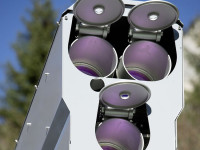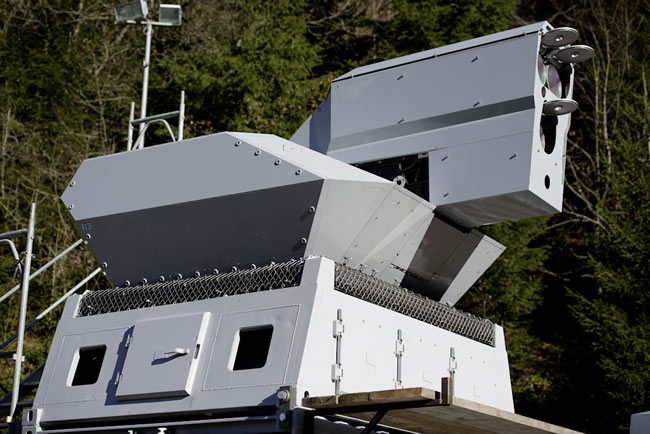
Rheinmetall has successfully tested a new 50kW high-energy weapon technology demonstrator. Defense-Update reports. The test was conducted at the end of November 2012, at the company’s Ochsenboden Proving Ground (EZO) in Switzerland. The test comprised three types of targets representing hardened targets, Unmanned Aerial Vehicles (UAV) and ballistic threats. and successful A steel ball representing a mortar round target, travelling at approximately 50 m/sec was also intercepted.
The test witnessed by independent experts was designed to demonstrate the increase in efficiency of the 50kW HEL weapon, compared with the 10kW version demonstrated last year. The five-fold increase in laser power was demonstrated how such high-energy weapon can effectively perform Air Defense (AD), Counter Rocket, Artillery, Mortar (C-RAM), and Asymmetric Warfare operations.
The tests proved how multiple HEL weapon stations can irradiate a single target in a superimposed, cumulative manner. This modular technology approach makes it possible to maintain the very good beam quality of the individual laser modules, while increasing overall performance several times over. Thus, from the technical standpoint, nothing stands in the way of a future HEL weapon system with a 100kW output – considered the optimal power level for C-RAM weapon.
For this test Rheinmetall used its using HEL emitters employing the company’s Beam Superimposing Technology (BST). The 50kW HEL weapon technology demonstrator consisted of two functional models. One system comprised a 30kW weapon station integrated into an Oerlikon Revolver Gun air defense turret for static and dynamic tests, coupled with an Oerlikon Skyguard fire control unit. The second system used a 20kW weapon station integrated into a Revolver Gun turret of the first-generation, patched in for static tests. External power supply modules supported both systems.

In the first test the 50kW laser was fired from a distance of 1,000 meters, cutting through a massive, 15mm-thick steel girder.
In the second test series the system engaged drones simulating UAVs. The Skyguard radar detected the incoming UAV at a distance of three kilometers. This data was handed over to the 30kW weapon, providing rough tracking using mechanical slew. At this stage, the optical tracking system in the Beam Forming Units (BFU’s) in each of the individual leaser weapon modules performed fine tracking of the nose-diving UAVs. After reaching the programmed fire sector the laser weapon modules engaged the UAV’s immediately and destroyed them within a few seconds, at a range of two kilometers.
The third test simulated the detection, pursuit and successful engagement of an extremely small ballistic target addressing potential Counter Rocket, Artillery and Mortar (C-RAM) application. A steel ball measuring 82 mm in diameter and travelling at approximately 50 m/sec replicated a mortar round type target. The Skyguard fire control unit immediately detected the target, followed by mechanical tracking with the 30kW laser weapon station. At this point, the BFU of the laser weapon module took over, optically tracking the target, which was then engaged and destroyed in flight.
According to the test data, Rheinmetall experts claim that by using BST, the time necessary for engaging mortar rounds at long ranges can be substantially reduced. Today, the required engagement time is already low enough to be in the region needed for C-RAM applications – even when adverse weather conditions make targets difficult to detect.
“These tests have silenced the skeptics, proving that Rheinmetall’s HEL weapon technology demonstrators can neutralize targets even under the most difficult weather conditions, including snow, dazzling sunlight, ice and rain.” Rheinmetall sources noted. The tests also proved the company have mastered the energy and cooling requirements of a future HEL weapon system in weight, size and power (SAWP) applicable to operational scenario requirements. Compared to last year, Rheinmetall has significantly increased the power density (kW/m3) of the technology demonstrator, enabling it produce twice the laser output within the same volume.
To further enhance this capability Rheinmetall plans to introduce a 60kW technology demonstrator in 2013, providing even greater laser output. Besides laser weapon stations, the plan calls for integrating 35mm Ahead Revolver Guns into the system adding close-in defense, thus establishing ‘multi-layer C-RAM’ system. This will enable Rheinmetall engineers to identify and study possible synergies between laser weapons and automatic cannon. Lower-power applications are also studied, as part of a mobile HEL weapon. This concept was successfully implemented with 1kW functional model mounted on a special TM170 vehicle. Next year the company plans to experiment with such systems on other platforms, exploring the operational parameters for integrating an HEL weapon on vehicles operating in an open battlefield.
Source: Defense-Update













